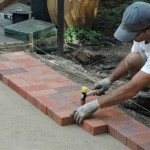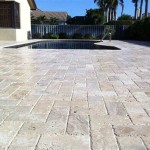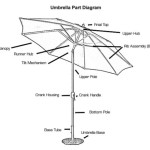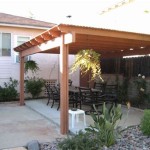How To Fix a Broken Concrete Patio: A Comprehensive Guide
Concrete patios, while durable and aesthetically pleasing, are susceptible to damage over time. Factors such as weather exposure, heavy foot traffic, ground movement, and improper installation can lead to cracks, crumbling, and uneven surfaces. Addressing these issues promptly is crucial not only to maintain the patio's appearance but also to prevent further deterioration and potential safety hazards. This article provides a detailed guide on how to repair a broken concrete patio, outlining the necessary steps, materials, and techniques for successful restoration.
Identifying the Cause and Extent of the Damage
Before commencing any repair work, it is paramount to thoroughly assess the damage to the concrete patio. This evaluation will determine the most appropriate repair methods and materials. Different types of damage require different approaches. Understanding the underlying cause is also crucial to prevent the recurrence of the problem after the repair.
Types of Concrete Patio Damage:
Cracks: Cracks are the most common type of damage. They can range from hairline fractures to wide, deep fissures. Hairline cracks, often caused by shrinkage during the curing process, are generally cosmetic. Wider cracks, especially those with displacement (one side higher than the other), may indicate structural issues, such as ground settlement or tree root intrusion. Map cracking, characterized by a network of interconnected cracks, often indicates surface deterioration due to weathering or excessive exposure to de-icing salts.
Spalling: Spalling refers to the flaking or chipping of the concrete surface. It is typically caused by water penetration followed by freezing and thawing cycles. As water freezes, it expands, creating internal pressure that can break down the concrete. De-icing salts can exacerbate spalling by increasing the amount of water absorbed by the concrete.
Pitting: Pitting involves small, shallow depressions on the concrete surface. It is often caused by aggregate pop-outs, where small pieces of aggregate near the surface break free due to weathering or chemical reactions.
Uneven Surfaces: Uneven surfaces can result from ground settlement, heaving, or improper installation. These irregularities can create tripping hazards and detract from the patio's appearance. Significant elevation changes often require more extensive repairs, such as mudjacking or slab replacement.
Assessing the Extent of the Damage:
Begin by visually inspecting the entire patio surface. Note the location, size, and type of each crack. Use a measuring tape to record the width and depth of the cracks. Look for signs of spalling, pitting, or unevenness. Take photographs to document the condition of the patio before beginning any repair work. This documentation can be useful for future reference or insurance claims.
To determine the cause of the damage, consider the following factors: the age of the patio, the type of soil beneath the patio, the presence of nearby trees, and the exposure to weather conditions. If you suspect ground settlement, consult with a structural engineer to assess the stability of the underlying soil. Identifying and addressing the root cause of the damage will significantly improve the longevity of the repair.
Repairing Cracks in Concrete
Repairing cracks in a concrete patio is a common task that can prevent further deterioration and enhance the patio's appearance. The specific repair method depends on the width and depth of the cracks. Hairline cracks may only require a surface sealant, while wider cracks may need to be filled with a patching compound or epoxy.
Materials and Tools:
Before starting the repair, gather the following materials and tools: concrete crack sealant (for hairline cracks), concrete patching compound or epoxy (for wider cracks), wire brush, hammer, chisel, shop vacuum, putty knife or trowel, safety glasses, and gloves.
Repairing Hairline Cracks:
Hairline cracks, typically less than 1/8 inch wide, are primarily cosmetic issues. To repair them, follow these steps:
1. Clean the crack thoroughly with a wire brush to remove any loose debris or dirt. Use a shop vacuum to remove any remaining dust.
2. Apply a concrete crack sealant to the crack. These sealants are typically available in tubes and can be applied with a caulking gun. Follow the manufacturer's instructions for application.
3. Smooth the sealant with a putty knife or trowel to blend it with the surrounding concrete surface.
4. Allow the sealant to dry completely according to the manufacturer's recommendations.
Repairing Wider Cracks:
Wider cracks, typically greater than 1/8 inch wide, require a more robust repair. Use a concrete patching compound or epoxy to fill these cracks.
1. Prepare the crack by widening it slightly with a hammer and chisel. This will create a better bond for the patching material. Undercut the edges of the crack to provide a mechanical lock for the repair material. Remove any loose debris or dirt with a wire brush and shop vacuum.
2. Mix the concrete patching compound or epoxy according to the manufacturer's instructions. Use a mixing paddle and drill to ensure a thorough mix.
3. Apply the patching compound or epoxy to the crack using a putty knife or trowel. Press the material firmly into the crack to ensure it fills the entire void. Overfill the crack slightly to allow for shrinkage during the curing process.
4. Smooth the surface of the patching compound or epoxy with a putty knife or trowel to blend it with the surrounding concrete surface. Feather the edges of the repair to create a seamless transition.
5. Allow the patching compound or epoxy to cure completely according to the manufacturer's recommendations. Keep the repaired area damp during the curing process to prevent cracking.
Repairing Spalling and Pitting
Spalling and pitting can detract from the appearance of a concrete patio and can also lead to further deterioration if left untreated. Repairing these issues involves removing the damaged concrete and applying a patching compound to restore the surface.
Materials and Tools:
Gather the following materials and tools: concrete patching compound, wire brush, hammer, chisel, cold chisel, shop vacuum, putty knife or trowel, safety glasses, gloves, and optionally, a concrete grinder for larger areas of spalling.
Repairing Spalling:
1. Prepare the damaged area by removing any loose or crumbling concrete with a hammer and chisel. Work carefully to avoid damaging the surrounding concrete. A cold chisel can be useful for removing larger pieces of spalled concrete. For larger areas of spalling, a concrete grinder can be used to remove the damaged surface more efficiently.
2. Clean the area thoroughly with a wire brush to remove any debris or dust. Use a shop vacuum to remove any remaining particles. The surface should be clean and free of any contaminants that could interfere with the bond of the patching compound.
3. Mix the concrete patching compound according to the manufacturer's instructions. Ensure the mixture is thoroughly blended and free of any lumps.
4. Dampen the prepared area with water. This will improve the bond between the patching compound and the existing concrete.
5. Apply the patching compound to the damaged area using a putty knife or trowel. Press the material firmly into the void to ensure it fills the entire area. Overfill the area slightly to allow for shrinkage during the curing process.
6. Smooth the surface of the patching compound with a putty knife or trowel to blend it with the surrounding concrete surface. Feather the edges of the repair to create a seamless transition.
7. Cure the patching compound according to the manufacturer's instructions. Keep the repaired area damp during the curing process to prevent cracking. Cover the area with plastic sheeting to retain moisture.
Repairing Pitting:
Repairing pitting follows a similar process to repairing spalling, but typically involves smaller areas. Clean the pitted areas thoroughly with a wire brush and shop vacuum. Apply the patching compound to the pits, ensuring they are completely filled. Smooth the surface and cure the patching compound according to the manufacturer's instructions.
Addressing Uneven Surfaces
Uneven surfaces on a concrete patio can pose a safety hazard and detract from its appearance. The repair method depends on the severity of the unevenness. Minor variations can sometimes be addressed with a self-leveling concrete compound, while more significant elevation changes may require mudjacking or slab replacement.
Self-Leveling Concrete Compound:
Self-leveling concrete compounds are designed to create a smooth, even surface over existing concrete. They are suitable for correcting minor unevenness, such as slight dips or variations in elevation. These compounds are typically self-curing and require minimal effort to apply.
1. Prepare the surface by cleaning it thoroughly. Remove any loose debris, dirt, or oil. Use a pressure washer to ensure the surface is clean and free of any contaminants.
2. Apply a concrete primer to the surface. This will improve the bond between the self-leveling compound and the existing concrete.
3. Mix the self-leveling concrete compound according to the manufacturer's instructions. Use a mixing paddle and drill to ensure a thorough mix. The consistency should be similar to pancake batter.
4. Pour the self-leveling compound onto the uneven surface. Allow it to flow and spread naturally. Use a gauge rake or smoother to help distribute the compound evenly. The compound will flow to the lowest areas, filling in any dips or irregularities.
5. Allow the self-leveling compound to cure completely according to the manufacturer's instructions. Avoid walking on the surface during the curing process. Protect the surface from rain or other moisture.
Mudjacking:
Mudjacking, also known as slab jacking, is a process of raising sunken concrete slabs by injecting a slurry of mud, cement, and other materials beneath the slab. This technique is suitable for correcting more significant unevenness caused by ground settlement.
The mudjacking process typically involves drilling small holes through the concrete slab. A slurry is then injected through these holes, filling the void beneath the slab and raising it back to its original level. Once the slab is level, the holes are patched with concrete.
Mudjacking is a specialized process that requires professional equipment and expertise. It is recommended to hire a qualified contractor to perform this repair.
Slab Replacement:
In cases of severe damage or significant unevenness, slab replacement may be necessary. This involves removing the damaged concrete slab and pouring a new one.
Slab replacement is a more extensive and costly repair than other methods. It requires careful planning and execution to ensure a successful outcome. The process typically involves the following steps: Removing the existing concrete slab using jackhammers or other demolition equipment. Preparing the subgrade by compacting the soil and adding a layer of gravel. Setting forms to contain the new concrete pour. Pouring and finishing the new concrete slab. Allowing the concrete to cure properly before removing the forms.
Slab replacement is best left to qualified concrete contractors who have the experience and equipment to perform the job safely and effectively.

5 Ways To Fix Ed Or Damaged Concrete Patio Cricket Pavers

How Can I Salvage A Crumbling Ed 24x24 Triangle Shaped Concrete Patio Without Tearing It Out Hometalk

How To Fix S In Concrete

Ed Concrete Patio Restoration For 60

Need Ideas For My Ed Concrete Patio

How To Repair Broken Concrete Fix Driveways Patios Sidewalks Pool Decks

How Can I Salvage A Crumbling Ed 24x24 Triangle Shaped Concrete Patio Without Tearing It Out Hometalk

How To Repair And Resurface Old Concrete Patios Fixing Ugly

How To Fix Ed Uneven Concrete Patio Surface

How To Repair And Resurface Old Concrete Patios Fixing Ugly
Related Posts








